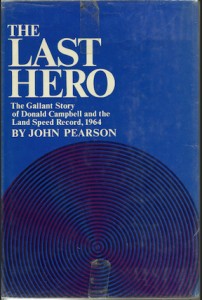Prodrive: 40 Years of Success
by Ian Wagstaff

“There are vast expanses still to be explored that go way beyond the access provided by asphalt roads.”
—David Richards
The first time I saw David Richards was on a foggy November night in 1981. The scene was a pine forest in the English Lake District and Richards was hunched over his maps in the passenger seat of a speeding Ford Escort RS 1800. Ari Vatanen was at the wheel and drove the Escort to second place in the RAC Rally, en route to becoming world champion, with Richards also winning the award as his co-driver. Tellingly, the Ford was sponsored by Rothmans, the tobacco firm whose livery was to adorn many Prodrive competition cars. And Prodrive is, of course, the firm Richards founded in 1984 and which has enjoyed great success in almost every discipline since.

Porter Press has produced a well-designed and superbly illustrated book to tell the Prodrive story. There is a strong sense that the book is effectively Prodrive’s 40th birthday present to itself. While that isn’t a bad thing per se, this book is not a “warts and all” account of the firm’s decades in the sport, as the tenor of the text is relentlessly upbeat. One is reminded that author Ian Wagstaff is both a seasoned—and award-winning—motorsports writer and also a PR man.
The near 200-page book is divided into two parts described respectively as “The Prodrive Story” and “Prodrive Heroes,” with the latter covering the firm’s key activities, from rallying via Le Mans to advanced technology projects. What this book isn’t is a David Richards biography, fascinating though that might have been. Prodrive have won at just about everything they’ve attempted, of course, but Richards has also achieved recognition in other spheres, not least in his role as chairman of Motorsport UK, the sport’s national governing body.

This book is not a deep dive into the minutiae of Prodrive history as the text is relatively brief. This landscape-format book will sell on the quality of its images. “Iconic” is the most overused adjective in journalism but in the case of the 555-liveried Subaru Impreza nothing less will do. Its origin is recounted here: “In those days most rally cars would be white with stripes down the side and sponsors’ names. They all looked the same. Jimmie [marketing manager Jimmie Rembiszewski] said ‘we don’t do that . . . and we just painted it blue with ‘555’ in the biggest sign writing that we could.’” The legacy (sorry, couldn’t resist) of that livery can be seen to this day—Imprezas are no longer as common as they once were but, in the UK, I reckon 8 out of 10 are in THAT blue. In 2024 there are many alternative ways to advertise your product than there were pre internet but, in the Eighties and Nineties, the impact and recognition factor of Prodrive sponsor brands was huge. Dave Richards was instrumental in introducing the Rothmans brand to motorsport, and Bastos and Mobil were also part of the Prodrive iconography in its early years, usually seen on E30 BMW M3s. That era seems like ancient history now that tobacco advertising is illegal, and association with fossil fuel brands can trigger cancellation on social media.
The author gives the reader a whistle stop tour through Prodrive’s greatest hits. There’s rallying of course, including rally raids such as the Paris Dakar, there’s touring cars (such as the BTCC-winning Mondeo and Australian V8 supercars) and even Le Mans, where Prodrive enjoyed success in the glorious-sounding Ferrari 550 Maranello GTS as well as a host of Aston Martins. But hold on, what about Formula One? There was a sense in the late 1990s that Richards was destined to become one of the biggest fish in the Piranha Club, but it never really happened. There was a single year at Benetton before the family thought his ideas “too radical,” followed by BAR, the team that ultimately became Mercedes F1, via Honda and Brawn. BAR had a stormy genesis, with the team risking foundering on the rocks of its own ambition, at least as visualized by Craig Pollock. Richards became the proverbial safe pair of hands, with BAR no longer being the joke team that talked a good fight. But Honda took the team in-house and, as they say, the rest is history. But I can’t help thinking that Prodrive had (has?) unfinished business with F1, especially now that F1 truly has a global audience. One senses there is a bigger story to be told here—were Richard’s fingers burnt by his short F1 adventure? Curiously, there is no mention of Prodrive’s involvement in 1998 with Christian Horner’s Arden International team. Prodrive took a 50% stake in the F3000 team, which was bought back by Horner the following year. He’s done rather well since . . .

One can imagine this book being given to potential sponsors after the slick presentation at Prodrive’s Banbury HQ. The prose sometimes resembles a series of press releases, studded with the sort of quotations that are never spoken outside a marketing schtick: “The Prodrive culture would give him the opportunity to push the boundaries.” There is the occasional bum note—in an era where firms brag about their green credentials the David Richards’ comment at the top of this review might seem to some as cloth-eared.

But look, I’m not the target reader and anybody wanting to work with Prodrive is going to be impressed with a corporate CV like theirs. In Europe perhaps only Dallara has a comparable record and brand recognition, although the Italian firm’s speciality is single seaters. Prodrive is now effectively a group of businesses, ranging from consultancy work for OEMs such as JLR and McLaren, to composites, road and competition cars, and branding, the latter via Brand&. Nope, me neither, but I don’t work in marketing so what do I know?
My enthusiasm for this book is not unbounded and I think that the Prodrive story does merit a more objective telling in future. But, crikey, those pictures . . . a sideways Colin McRae, a Rothmans Porsche 959, those hunkered-down touring cars, or even the Hero Era 1967 Mustang created by Prodrive Legends. Trust me, they are all just gorgeous and are the main reason to buy this book.
Copyright John Aston, 2024 (speedreaders.info)


 RSS Feed - Comments
RSS Feed - Comments





































































 Phone / Mail / Email
Phone / Mail / Email RSS Feed
RSS Feed Facebook
Facebook Twitter
Twitter